#sotus s
Explore tagged Tumblr posts
Text
sotus and sotus s were kinda way ahead of their time and nobody is ready for this conversation
Yes it did receive appreciation for being a trendsetter of university setting in BLs but the criticisms on lack of intimacy is getting on my nerves.
First of all, the main focus seems to be on the senior-junior struggle with hazing and the characters' internal struggles. THE AIM WAS NOT FANSERVICE AT ALL.
With that being said, it is completely normal for them to NOT be all over each other on screen even in season 2. Portraying emotional intimacy is harder than physical & it's done beautifully. They are two boys trying to graduate and do well in their jobs, it's absurd for them to come home and be all energetic in bed.
The relationship is actually balanced in its own way. Arthit gets a lot of hate for not communicating enough. When it actually does not seem like the case. Because in s2 he tells Kong "We can normally talk about anything, right?" That actually shows they are close enough to have tough conversations without jeopardising their relationship. Arthit knows since s1 that Kong is a rich kid, only he never know who exactly his father was.
Moreover Arthit's introversion & mysteriousness is what seems to draw Kong to him. We see how possessive Kong is - he cannot stand anyone else knowing little details such as pink milk & Aioon. I bet he'd not like him if Arthit was an easily likeable popular extrovert. The fact that Arthit is visibly shy is enough for Kong. And the fact that Arthit does not say "I love you" or "You are my world" regularly is what makes his words more valuable. Because Kong knows that it means beyond the surface in a situation when he says it.
It's good that Arthit continues to be shy & silent even in s2. Because that shatters the most common misconception that people change. He himself says that he loves Kong regardless, and saying it everyday would only reduce its importance. (Also, he's shy & that's how he is. Kongpob can accept it so it's all good innit?) Despite taking a long time to deal with his inner struggles he always comes back. He doesn't go around announcing about his relationship, but he does not keep it a secret forever either.
And the fear of society is actually well portrayed. University & workplace is different. Your sexual orientation doesn't reflect on your academic reports, but it CAN reflect as workplace discrimination. We also see that Arthit slowly realises that nobody is gossiping like he imagined. That's how he learns how pointless his worries were.
There are other shattered stereotypes. Such as the owner's nephew being a hard worker unlike the general nepotism character. And Earth just taking her time to warm up instead of turning out to be the female villian.
With all this being said, the show has a balance of silly entertainment & realistic ish character growth, idk it's a hill I'm willing to die on kbye.
#sotus#sotus s#sotus the series#gmmtv bl#gmmtv series#gmmtv#thai bl#engineering bl#krist singto#kongpob x arthit#aioon#arthit#kongpob#thai boys love#rants n rambles
190 notes
·
View notes
Text
Hello Neighbor
Well now that we know that Cir "just happens" to live in the same building as Phu, but just one floor down, I think we should talk about some other BL couples who just so happen to live in the same damn building as each other. Sometimes someone is aware and sometimes it's a total shock for everyone.
CirPhu from The Boy Next World. Like I said, last week Cir just casually revealed to Phu that he lives in the same building but just one floor below him. It's a bit weird for him to suddenly reveal that especially after claiming that he and Phu are lovers in another timeline somewhere. Do we believe he's a stalker? Or do we believe he's truly from another world and it's just coincidence that he lives in Phu's building? Let's place bets rn.

WinTeam from Until We Meet Again/Between Us. Win lived on the floor above Team in their dormitory and his room was right over Team's. Team living in Win's dorm definitely came in clutch for Team because he had somewhere to go when he couldn't sleep...which was every, single night. And Win gladly welcomed Team into his space and even offered him a key. They weren't just neighbors, Win's dorm was Team's sanctuary.

GeneNubsib from Lovely Writer. Nubsib was a proud stalker of his beloved Gene. He purposefully bought the condo directly next door to Gene's and didn't tell him. So when Gene kicked his ass out he just silently moved in next door and was just like "SURPRISE SHORTY!" And we all just ran with it. It is 1000% possible that Cir is pulling a Nubsib.

KongArthit from SOTUS. Kongpob was BOLD because he pulled this stunt TWICE on Arthit. First he didn't tell that man that his dorm was directly across from his in the opposite building. He just spent a few months lurking at Arthit from afar, enjoying the show of his cute senior fumbling around. THEN when Kong went to intern at the engineering company Arthit worked at (something else he didn't mention) he purposefully moved into the condo right next door to Arthit and once again DID NOT tell him. He just let his mans find out and was like, "See...what had happened was..."

PatPran from Bad Buddy. The Gods just blessed them to be in each other's spaces eternally. We all know PatPran were warring neighbors since childhood, the Romeo and Juliet of it all, but not them being across-the-hallway neighbors at uni too. Of course Pran seemed annoyed but Pat couldn't be more thrilled to be living next door to his most favorite dimply guy. Pat did seem to spend most of his free time at Pran's place, but that was partially because his baby sister was cramping his style when she moved into the dorm with him. But whatever because he got to annoy and snuggle his favorite guy.

VeeMark from Love Mechanics. What's fun about VeeMark living directly next door to each other was that Mark was Vee's side piece. Some days he was burning with rage that Vee lived next door with his girlfriend but also cackling other days because he was fucking that girl's man on the regular right under her nose. They was on some messy type shit. Wait, now that I think about it...that was ole girl's apartment so Vee was legit just bouncing around from room to room with whomever he felt like cuddling with that night. With his choosing ass.

GodDiew from Monster Next Door. They win because they were semi-anonymous next door neighbors for a long ass time. Gettiing to know each other without seeing each other. Dating while not meeting up. Romance blossoming while vaguely in each other's presence. Bonding without actually breeching a physical boundary until they were both ready. Their being neighbors and how they were neighboring was actual poetry.

I think 2025 might bring back my lists. I can't contribute much but I can make a fun random list. Hope you all enjoyed this.
#cirphu#the boy next world#boy next world#winteam#between us#until we meet again#gene x nubsib#lovely writer#kongpob x arthit#sotus#sotus s#veemark#love mechanics#goddiew#monster next door#patpran#bad buddy#I FORGOT TO TAG BAD BUDDY
246 notes
·
View notes
Text




let's just all ignore the entire ocean in the background
#sotus s#sotus s the series#sotus the series#2x09#arthit rojnapat#kongpob suthiluck#krist perawat#singto prachaya#gifset#*brace's#//#so sad#but oh well#there's nothing that could be done ig :/
40 notes
·
View notes
Text
#thai bl#together with me#tharntype#cause youre my boy#uwma#dark blue kiss#sotus#sotus s#theory of love#itsay#ipytm#2 moons 2#2gether
91 notes
·
View notes
Text
SOTUS S: The Secret Four-Act of Love Between Us
Five episodes into SOTUS S, I wanted to cry. Nothing tragic had happened. The major plot climaxes were nowhere near. If I'm honest, I had felt pretty indifferent to the sequel series up to that point. Its more expensive production elements, relaxed pace, comedic sound queues, broader characterizations, and blatant callbacks to the original series seemed more akin to cash-grabbing commercial projects that followed in SOTUS's wake. Some were fun and some fell flat, but those series lacked the show's layered writing or direction. By the end of episode 5, however, something shifted. It continued to surprise my narrative expectations from there on out, offering new ways to appreciate many other BL series due to the clarity of its formal structure. This review is my attempt to understand how and why.
SOTUS S doesn’t primarily operate by the most prominent Western storytelling rules—the three act or five act structures that build toward a culminating conflict for a climax before an exhaustive resolution. Nor does SOTUS S make as much of an attempt to blend its structure in with the Western storytelling rules as its predecessor did. Instead, it’s a striking example of the Four-Act structure (from hereon: 4Act) that developed in China and spread to Japan, Korea, and Southeast Asia as noted by @kimyoonmiauthor. It’s prominently used in Japan by manga, anime, novelists, and game creators under its Japanese name Kishotenketsu. If you’ve heard about “the three episode rule” in which you have to watch the first three episodes of an anime before passing judgment, that’s often unknowingly related to the principles of the 4Act structure.
Rather than refer to the Kishotenketsu model here, however, I’d like to use the four parts as defined by the original Chinese poetic form in Adeline Bindra’s explanation for the Savanna Post:
Qi– Bringing into Being
Cheng– Understanding
Zhuan– Changing
He– Drawing Together
I’ve found these definitions more helpful for understanding than the Japanese terms and their English translations, like “introduction,” “twist,” “development,” etc, which have meanings in the Western tradition that differ from they’re use in the Asian narratives.
Some caveats:
1. I’m an American just trying to figure this out from my own experiences with Asian media and others’ writings about the structure and cultures that utilize it. There’s a ton of Orientalism in writing about the subject of the 4Act structure, and I try my best, but I can’t promise I won’t accidentally slip into some of that rhetoric.
2. No single culture’s a monolith, so not every writer in the cultures will use these structures the same or at all, and the different cultures referenced here—Thai, Japanese, Chinese, Korean—also differ dramatically between one another, and so do their approaches to the 4Act.
3. Cultures have been interacting and changing forever. Shakespeare included a reference to a Christianized translation of the Buddha’s story in Merchant of Venice, for one example. Asian influences have been a part of Western writing for a long time and vice versa. Western media’s pervasive throughout the world. Inevitably, you’ll see shared aspects from intermingling as well as convergent development. My goal is not to essentialize any people, culture, or story, only to isolate in this instance the feature of the 4Act in SOTUS, which has well-documented Asian roots.
4. This is a narrative structure not a moral guide on how one should live life at all times. Some writers claim ethical, political, and philosophical implications for its use. However, you get to be the judge of when and how to use it in your perspectives as an audience, creator, and a human being just making it through in the world.
5. Thai culture has its own specific traditions around this structure and other plot structures that I’m not focusing on here simply for lack of info in English. I’d love to hear more about that from others more knowledgeable than me. Is it taught in schools or writing classes? Does it relate to other Thai dramatic structures? I don’t have the answer, but my mind is inquiring to anyone who does!
6. As with all my posts, feel free to message me about or correct me on mistakes or add more context where I falter.
Hopefully in isolating and differentiating the 4Act model as much as possible from the Western model here, I can demonstrate the latter’s importance to SOTUS S and many other BLs. From here, I’ll try to do a side-by-side comparison of the elements of that 4Act structure with SOTUS S. Spoilers abound for SOTUS S along with several other BLs.
Qi: Bringing into Being
Premiering in 2018, SOTUS S offered audiences one of the first examples that I know of a BL live-action about an unequivocally established couple. That fact necessitates a model distinct from the traditional romantic arc you’d find in guides like Romancing the Beat by Gwen Hayes and graphed below by Jenna Harte.

With an established couple, the whole first act of this three act structure is useless. Our pair already met and they like each other. We already watched them fight through this whole mountainous arc to achieve their romantic HEA (happily ever after for those unaware).
Here’s where our 4Act comes in. Qi, our first act, rather than setting up the characters with some spark the protagonist will have to deal with later on, focuses more heavily on establishing the environment the characters exist within. It's less pressed about setting its conflict into motion. As Jay Six explains helpfully in his self-published book, A Practical Guide to: Kishotenketsu, “The story often starts by establishing a detailed, richly textured world. This focus on observation allows readers to immerse themselves in the environment and the characters, setting up a deep connection with the narrative.” In SOTUS S, that means we get domestic fluff with gentle implications about Kongthob and Art sleeping together. We wander the campus to see Kongpob’s friends in the engineering faculty, now in their third year and in the position of hazers (distinct from the American concept for anyone who’s unfamiliar) to a new set of freshmen. We greet Arthit’s friends at the bar. Then, we follow Art to the new setting of an engineering firm where he’s beginning employment after an internship. You will be taken aback if you, like me, expected all of these characters and settings to be relevant to the action throughout the series.
I have a brain trained to expect the beginnings of a story to provide a clear impetus for a central problem, as if the story ought to have an on-switch that starts the gears of the narrative turning. My first instinct when it became apparent SOTUS S had not done that was to ascribe the emergences and dissipations of certain elements at the university as service to fans of the original series—let them get a taste of the characters, coupledom, and little university scenes they loved before moving onto the meat of the plot.
That’s a natural expectation when you’re used to stories focusing exclusively on conflict and individual power. Each piece of the story should link to their effort toward their goal. Bindra describes the ‘dharmic structure’ of the Western narrative arc: “The character is pursuing a specific Dharma, a ‘path’ or ‘way,’ toward a tangible end goal.” Whether they succeed or fail matters greatly under this framework.
In opposition is the ‘Karmic structure,’ where characters “simply go about their lives until they are forced to react to some bizarre, unforeseen circumstance.” All the elements matter in the Karmic structure but not as a set of stairs the protagonist climbs or a steady accumulation of coins to pay off in the end. The general environment has a larger role to play and the individual has less responsibility in the events that unfold, which impacts the opening. Anaea Lay’s description explains the emphasis on thematic development in the beginning over a Western plot ignition.
“You are much less likely to run into an “inciting incident” or similar in this introduction than you would in an X-Act structure. Instead, what you’ll find are the themes and images the work will be using. You aren’t here to find out what kind of wild ride you’re about to engage in; rather, this is setting you up for what argument or ideas you’re about to witness.”
That’s why anime fans have a three-episode rule before deciding on their engagement with a series. Those first three episodes have no obligation under the 4Act to indicate the adventure that’s about to occur.
In the first episode we see Arthit stumble through a disorganized orientation to his first day at work, joining the procurement department at an engineering firm, a stepping stone towards a role at the company more suited to his interests. During an early meal out with his new coworkers, he misses the opportunity to share his relationship with his coworkers. His nervousness is palpable in the moment, and Krist shines in portraying Arthit’s acute anxiety realistically throughout the show. The fear of homophobic reactions isn’t made explicit, but the subtext can’t be ignored with the dramatic music, forlorn expression, and greater context.
Yet, the show is generous enough to present a moment of possibility, too, where Art seems about to share about his partner before getting interrupted. Bravery isn’t a singular character trait, the scene suggests, but a fleeting feeling dependent on circumstance and luck. It renders the ‘coming out’ narrative that emerges for Art a bit different—less individual and insurgent than the classic western coming-out narrative in, say, The Birdcage or Love, Simon. He has legitimate interests in the appropriate setting, occasion, and timing to maintain positive relationships. He didn’t lack courage as much as he missed the proper moment.
I’m not of any kind of Asian descent, but these were major values in my personal family culture. I only came out to my family once I had a partner and a cousin’s new same-sex partner came up in conversation at the dinner table. My family simply didn’t discuss internal emotional states, straight or queer, my parents didn’t kiss in public or in front of me and my sister, so bringing up a sexual identity without any outward indicator of my own sexuality didn’t make sense.
And before anyone jumps to the conclusion that this was some deeper issue of generational repression, know that plenty of research backs up this collectivist-oriented relational style as a broader Appalachian cultural norm (which my family exists within). While no culture exists totally on one part of the spectrum, it like most East and Southeast Asian cultures gets categorized as a high context culture, which prioritizes interpersonal relationships and draws on less direct verbal and nonverbal communication strategies to artfully maintain them when possible. Further research, much of it collected in the fascinating book, Between Us: How Cultures Create Emotions by Batja Mesquita, frames psychological well-being not in a single universal way of interacting, but in interactions and understandings that align beneficially with one’s surrounding culture.
“I’m working [at the company] already,” Arthit in bed advises Kongpob, “but I still have to learn to adapt.” There’s the crux of Arthit’s story in SOTUS S: how can he find proper alignment of his own unique characteristics to integrate himself within his new work culture, in a department he had little desire or skills to master? Protagonists in a 4Act are responsive rather than goal-oriented. With the same acknowledgement that you can’t control the circumstances you’re born into, they don’t have control over the problematic circumstances they are thrust into by the karmic plot.
Arthit makes a great 4Act protagonist in SOTUS S. He isn’t the strict senior disciplinarian from the opening of the original series, nor is he the warm, open character healed by that show’s happy ending. The senior is now the nervous junior at the firm, eager to please and conform—these latter traits providing continuity with his original characterization. The junior, Kongpob, is now the authority, the head hazer at the university. These role-reversal topics were already thematically relevant in the first series, but SOTUS S makes them more explicit, bringing us into new territory and depicting an alternative view to linear character growth.
Kim Yoon Mi describes both Japan and Korea introducing a story’s main topic (not to be confused with main conflict) in the first act of this structure and then developing it more deeply in the second, which SOTUS S seems to do. Each character and story element, including the protagonist, is a trickling mountain stream feeding into a larger river of theme rather than plot. In line with that metaphor, some of those elements will evaporate or branch off before reaching the deep reflective pool where the story concludes. We’ll come to see as we reflect back how solidly the show in its first act laid down its thematic foundations: the dynamics between memories of the past (like university life) with the press of time, the blurry lines between private and public, the formation and maintenance of relationships, the privileges of status, and all of them weighted by pervasive queer anxieties that the writing elegantly restrains itself from stating outright. The next act of the show elaborates on all of this, but not in the direct sort of development Western stories prioritize.
Cheng: Understanding
If viewed from the perspective of a three-act hero’s journey, the second act of SOTUS S runs into some major problems. Here’s a graphic from author Patricia Morais (that I particularly like for its regrouping dip) explaining that structure:

Under this model, we could maybe think of Arthit’s failure to come out to his coworkers as the central inciting incident that must be resolved by the end of the story. If you’d like to be more generous, we might instead identify the incident in episode 2 to identify Art’s tag-along meeting with his overly-friendly coworker, John, and a representative from one of their materials’ providers. Then, our main plot focuses around the eventual plastic crisis for the company as the main conflict that will need resolution. However, the fact of dual plotlines that never merge hopefully encourages you to question the familiar expectations of a three-act structure or hero’s journey. Otherwise, you’ll come away from the show believing a lot of fat could’ve been trimmed off in the editing process.
In episodes 2 through 5, SOTUS S has some elements on which action can rise toward a major climax point. John shirks work off onto Arthit over and over again, for example, and another coworker, Earth—who for me so far in my BL viewing is the most grounded female character I’ve seen, not to mention my favorite—slowly reveals her kind heart behind her diligence. On the relationship front, Ai-Oon is running himself ragged trying to balance his work and relationship, losing his patience with Kong at one point when he shows up to the company with a food delivery.
But many other points don’t add to the plot the way they ought to for a hero’s journey. We get introduced to a few freshman, like Khaofang, whose crush on Kongpob gets gently denied, and Day, resistant to Kongpob’s enlightened initiation rituals, thus igniting the persistence of class president Tew. Neither of those freshman will contribute to the main plots for Kongpob and Arthit. On the faculty beach trip, now paired with tree-planting to skirt the stricter regulations, M and May finally confess their feelings percolating since last season for one another. After these confessions in episode 4 and a discussion of internships at the start of episode 5, they will not reappear until the last episode of the series.
So why include them? I showed charts for the Romance Plot and 3 Act structure above, but let’s look at a visualization of the 4Act from writing coach Anaea Lay.

You’ll notice some key differences. The line isn’t really progressing upward, for one. It also changes width in sections and even color by the end? I’ll discuss our squiggly twist and color change later, but for now let’s focus on our second act for cheng, Understanding, or “development” as the above chart has it.. We have this bold line emerge because the point of the second act, as Lay explains, is to create density, flesh out the topic, enrich it.
Instead of building up a structure or walking up a mountain path and overcoming obstacles along the way, the cheng stage kneads the narrative into interlocking thematic explorations like the structure of gluten in bread dough. Japanese writers refer to it as ma, a kind of slow infusion through time and spaciousness. You can develop a 4Act narrative with intensification, sure, and that will appear pretty similar to the three-act development stage—I personally think Hunter x Hunter arcs provide fantastic examples of second-act intensification strategies in a kishotenketsu model, and The Campfire team do a fantastic job of explaining how the series, Shogun, uses the 4 Act with escalating pressure in this stage. Yet other strategies also exist.
SOTUS S chooses to spread out its thematic question during this phase: to different plots, different people, even different times. Tew and Day, for example, who interact the least with our protagonists’ struggles out of any characters, nevertheless reiterate the values of persistence and faith as people develop ties. Despite Day’s overt resistance to the SOTUS rituals, Tew returns to him again and again, tuned into unstated signs of the freshman’s painful past, like his status as a transfer student, and subtle acts of participation in the events, indicating a secret desire for belonging. Art’s new coworkers provide another example of how much we truly know about others’ inner workings just based on first impressions.
Perhaps the most direct evocation of the main thematic tension occurs not with KongArt, but with M and May who only receive episode 4 for their story. As the freshman walk across their wrists to go receive their gear emblems, May finally demands clarity for feelings simmering since 2016. I’ve slightly shortened the exchange for brevity.
May: “You never bother to tell me your feelings directly.” M: “Do I have to say it out and tell you to make you understand?” May: “I don’t want to assume things.” M: “What I said on the stage…I meant you.” “You know…what it means, right?” May: “I don’t know, M. You could think of me as a close friend.” M: Well, I…like you. I like you more than a close friend. I want to be your boyfriend. I told you my feelings directly. Now it’s your turn to tell me your feelings. May: Are you crazy? There are so many people here. How can I say it?
It’s gorgeous naturalistic dialogue, stuttering and ambiguous, between two reserved characters! Reducing them to their role in the main plot, however, would render the characters and scene meaningless. M and May simply don’t contribute to the issues at Ocean Electric or KongArt’s relationship. They're an indirect illustration of the show's themes.
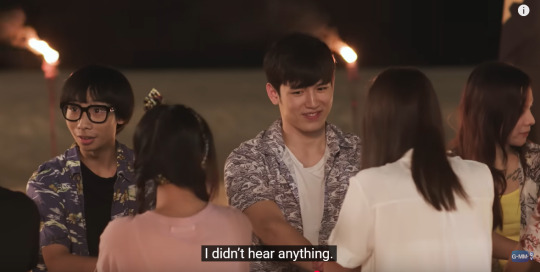
Indirect communication is central to SOTUS S. We see Kong and Art, open to their friends and on campus but conflicted in how open to be with their affection in public, bridge the gap through indirect displays: a conversation about liking the sea! shared taxi rides! an indirect kiss they share on an Oishi bottle! These coded romantic encounters can be downright erotic. The West doesn’t even have the concept of an indirect kiss, which is emblematic of the kinds of context that one can miss.
The show layers on reason-upon-reason for keeping affections nebulous: personal temperaments, professionalism, financial precarity, collective belonging, cultural mores on PDA, and societal homophobia, too. The show lays these issues out indirectly. For example, Art’s coworkers Som-O, Durian, and Cherry (the kind of lovely overtly queer character SOTUS did so well, played by Gun Korawit) all skirt the line of appropriate workplace conversations and behavior as they gossip and fawn over new employees. The tension of their flirtations against our knowledge about the fears and hidden relationships at the office is thick, but no one will really confront them directly about how close their speech and actions how they stress those in the closet, nor how close they come to sexual harassment.
Instead, other occurrences will cause them to reflect on behaviors. Cherry, for example, addresses his own behavior and his subordinates’ after news about Arthit and Kongpob becomes public. Cultures with high-context communication approaches utilize actions, behaviors, and symbols to convey messages rather than verbal specificity, so passive statements and unrelated events are seen as more effective in encouraging behavior change than direct communication about the issue. That’s why the 4Act structure and the indirect elaboration of ideas that occurs in the second-act align culturally. It doesn’t force its issue on the audience.
The most indirect formal element from my perspective occurred with the use of the ‘special scenes’ at the end of each episode, and they fully blew my mind by the time I realized how they were operating. I assumed these flashback scenes to KongArt moments were meant to give the fan-girlies the cute moments between the cute boys and their throwbacks to the og series. That’s how they often seem to work in other BLs. Stupid me, underestimating the series and fan-girlies, whose desires can be as multifaceted as any film critic or academic. The flashbacks at the end of each episode, in addition to their sweetness, emphasize moments of public affection between our main couple, but even more than that they intentionally throw us back in time, breaking up the linear story and a linear trajectory for Arthit’s comfort with public affection.
The special scenes aren’t simply detached scenes, they’re narrative switchbacks, forcing us an audience to meander like a river in the story. Kim Yoon Mi describes a major element of the East Asian 4Act: “While time is going forwards, the character is returning to a previous point in their life, re-examining it–or forced to reexamine it.” I described the original series as propulsive and unrelenting in its tempo and plotting. SOTUS S, on the other hand, is nostalgic and reflective in both content and its structure.
Arthit, tired from a day of work, rushes to his alma mater to catch the end of the flag ceremony. “When I get to see the atmosphere like this again,” he confides, “it’s like the fuel tank in me is filled. This can fill the feelings I have lost. My tiredness is gone. I have the strength to go back to work now.” For another example look at the contrast as episode 6 ends with Kongpob standing in an apartment hallway alone after an argument with his boyfriend. The show suddenly cuts to a past moment when Arthit let himself fall asleep on Kongpob’s shoulder in the back of a taxi. When we feel broken, worn-down, or lost, when we undergo big life changes, returning to our memories gives us an opportunity to repair ourselves and cherish the relationships we’ve made.

Meandering is the shape of easing—mountain roads that reduce the gradient of a climb, water seeking the least resistance. SOTUS S and its narrative structure explore these shapes. In addition to the purpose of nostalgia for its characters, it uses its position as a sequel to address why returning us to an older work might be emotionally useful and why an indirect path through time and our journeys might be nourishing. After the steady fabrication of its attachment to the original series in the first and second acts, the third act shift is all the more potent.
Zhuan: Changing
In the sixth episode, Kongpob joins Ocean Electric as an intern with the encouragement of his father, the CEO of a manufacturing firm Arthit has met and impressed without realizing his relationship to his partner. Kong had left the required internship applications to the last minute, at ease with the connections his wealth and father’s position in his field of study offer him. And with Arthit’s packed work schedule (not to mention Kong’s impish romantic fantasies that only stress out his partner), our nong doesn’t disclose his decision. Art is shocked and appalled when his boyfriend walks into a meeting and gets introduced as the new intern.
The show also introduces new central characters to the cast in the fifth and sixth episode, which is far too late for introductions of main characters in a traditional Western narrative approach. Wad, whose privilege as the nephew of Ocean Electric’s head honcho mirror Kong’s background, joins the procurement department. Another intern, Nai, also joins the proceedings. These characters and their softly-treaded dalliances at Ocean Electric fill in the space left as the story mostly abandons the university and all but two supporting characters we met there.
I've read complaints about that split in SOTUS S, the university-centered plots in the first half overtaken by the corporate setting. Personally, the viewing experience gave me a sense of how ephemeral life is. Four months pass by in a flash and Arthit’s no longer the junior at the office. The university storylines fall away like cherry blossoms or autumn leaves. If that sounds too poetic for you, I'd recommend you stick to the first series and its fantastic linear storytelling (and you can ignore the poetic elements that elevate it, while still enjoying the show). SOTUS S puts its indirect storytelling strategies at the forefront. That’s why I find SOTUS S such a great example to look at the 4Act. The overt shift here makes it hard to square with the continuity of traditional Western dramatic structures.
In the third act of a 4Act structure, the audience comes to understand a new perspective on the proceedings that the first two acts offered them. The Japanese term for it “ten” gets directly translated to ‘twist,’ but that term is so heavily associated with some plot-oriented ‘gotcha!’ moment in the western canon:
a new piece of evidence in a trial!
the sheriff is in cahoots with the robber baron!
Voldemort’s on the back of his head!
There are many reasons to view two of the most celebrated Western film twists, Star Wars’ paternity reveal and dead Bruce Willis in The Sixth Sense, as blendings with the Eastern third act’s Change. The overt declarations made by characters to render the twists apparent to audiences in those instances along with the instrumental role the change plays in the character’s journey is rooted in Western storytelling. However, the impact it has on how the audience interprets the story, both preceding events and the purpose of the story as a whole, is more akin to the kind of change that occurs in the Eastern model. The zhuan or Change here is less emphatically about a reveal of information and more about a change the audience experiences in their type of engagement with the story.
Youtuber ‘Pause and Select’ relates the change in the 4Act structure to space. Discussing Attack on Titan, which has the exceptionally clear spatial limit of tightly packed city walls, he explains it as a ‘parallax view,’ a shift in perspective for the audience. Going further, he asserts that the third act shift is NOT meant to be a last-ditch event or realization that aids the story in reaching the conclusions we expected it to reach based on the first two acts. Elle Woods finding out her boss is a skeeve and then taking over to use her knowledge about perms in trial to prove her client’s innocence is a great western ‘twist’ and climax, which includes every feminist element Elle has come to stand for in her development at Harvard law school and brings about the expected conclusion of her success at overcoming all her obstacles to truly become a successful lawyer. However, it does nothing to change the audience’s perspectives about the story’s goals as a female empowerment legal comedy.
“What matters,” Pause and Select argues about the 4Act change, “is that a breakdown, whether you are a reader or writer of [the 4Act structure], ultimately demands coming to a conclusion as to what you think the structure is trying to do.” The emphasis there is mine. A well-constructed 4Act aims to dislodge expectations about the very nature of the narrative it's telling in its third act. At its most obvious, this could be a genre shift—a romcom becomes a tragedy—but it might also be a change in whose perspective the story takes (Peaceful Property), which character is masterminding the events (a favorite of writer/director Park Chan-wook, like in The Handmaiden), or an expansion of who the audience is meant to feel empathy for (a fav strategy of Miyazaki, like in Laputa, Spirited Away and Princess Mononoke). A common romantic Kdrama trope of this kind, I hear, is the revelation that the characters previously knew each other. No matter the shift, thematic motifs will remain (a good reason to pay attention to indirect elements!), but the plot-type possibilities and full extent of the theme’s message can utterly transform.
When viewers use Western frameworks to complain about the poor build-up or the introduction of unexpected elements into the second half of BL series, the complaint often comes from a place of ignorance. I’ve even heard unfounded conspiracy theories about studio interference regarding the sense of the unexpected in these sections! When viewed with the goals of the 4Act in mind—and here we ought to note the Korean 4Act model, the giseungjeongyeol, which splits its 4Acts more evenly than the Japanese kishotenketsu, as Kim Yoonmi points out—an audience’s experience of disruption that begins around episode 6 of a 12 ep series can be a sign of successful storytelling and a chance to reevaluate what you assumed the story was going to be.
No wonder I found myself getting weepy around episode 6. Time itself is the core focus of SOTUS S. By the end of the second act in episode 5, the hazing rituals we endured for fifteen episodes in the og had flashed by and completed. I began to fully appreciate the breadth of how SOTUS S intended to instill the experience of no longer being what you were before, the experience of merging into the realm of adulthood where the flowing expanse of life is no longer broken into semesters or organized into class years nor the safety of their forcibly forged friendships. It's an exceptional feat of storytelling to induce that subtle emotional experience for an audience.
With that shift, the problems and consequences shift as well. A third act often introduces an entirely new obstacle. The boss of Ocean Electric announces the yearly product design competition, and the shady dealings of certain employees suggestively simmering in the first half rise to the surface. In a Western telling, the series could’ve easily started right here. It brings the conflict, the battle between good (Earth and Arthit) and evil (John and Som-O), along with the slight moral grayness of Todd to keep it interesting. The pace and tempo of the scenes pick up, especially when the shit hits the fan/the cheap plastic hits the production line. It thrills with the same surge that ran through a majority of the original series. Is this conflict what the story’s about, though?
Some people have described the 4Act as a conflictless plot structure. That’s baloney! You’ll see battle after battle after battle in shonen manga, like Naruto, Dragon Ball, One Piece, and Jujutsu Kaisen, all organized by the principles of The 4Act. SOTUS S shows off its ability to instill conflict with Ocean Electric’s design competition, too. The difference between the 4Act and the Three-Act or hero’s journey derives from the latter’s centralization of a single conflict compared to the former’s use of diffused conflicts—diffused in the sense of multiple conflicts spread out without a center, and, as I’ll explain for the last act, diffused in the sense of de-escalated.
The issue of the competition is one conflict beside a number of other dating conflicts, with KongArt’s the most prominent, none of which directly impact each other in terms of plotting. In this section, Todd slowly falls for Earth, who gently turns him down (again, with writing and a performance by Proud Oranicha that solidify Earth as a uniquely naturalistic female character in a genre known for campy female caricatures). The other new intern Nai (Nammon) and head of Production, Yong (Guy Sivakorn) begin the most discrete of bromances, or maybe something more…, until Nai feeling slighted draws back. And KongArt have it out about Kongpob’s surprise internship decision before making up, allowing Ai-oon opportunities to show his growing comfort in his secret bf’s surreptitious seductions in public.
And let’s all appreciate that the boys continue to engage in versatile powerplay dynamics with their displays of affection!

To properly center a single conflict for a Hollywood version of SOTUS S, all of these individual tensions would end up relating to one another—perhaps Todd and Nai become bitter about their rejection and join John’s plot to win the competition. Then, as a last ditch attempt to gain support for their own team’s entry, they discover and out KongArt’s secret relationship. Plenty of other options could take place, but the point is that they’re meant to be set up like that meme of ever-increasing dominos, building upon one another to create an even greater singular conflict. Instead, we see jealousies that come to nothing, slights that characters move on from without involving others. SOTUS S lets the different conflicts exist independently to separately emphasize the main theme: relationships take time, dedication, communication, and faithfulness to develop and maintain as people’s circumstances change.
The company beach outing provides the landscape for many of the relationship dramas to come to a head (and strikes a narrative beach episode beat with foundations exceeding the BL genre) before things go awry. If I’m honest, elements of Western Romance plotting seem to predominate this last portion of the third act: a false HEA (happily ever after) at the beach, disaster as the bad plastic goes on the line, and true crisis as office busybody, Durian, outs Kong and Art by sharing pics of them kissing from the beach trip. Then episode 12, as second-to-last episodes in romance series are wont to do, offers us a separation of sorts and a long dark night of the soul for Arthit before he arrives at his self-realization. It’s a beat integral to the 4Act and the Romance arc, but in the 4Act, despite its sometimes momentous occasion, the self-realization is secondary to the initial perspective-shift in terms of expected emotional and overall engagement from the viewer. Art announces he’s dating Kongpob in front of the entire office at the intern send-off. In the romance arc, the self-realization and confession change everything. The villains like Lady Catherine are dispelled; the curse on the beast breaks, Here, though; Love Wins! But here, we de-escalate.
He: Drawing Together
The 4Act sensibilities in SOTUS S resurface after the culmination. Arthit finally announces his relationship in front of the whole office, but no character stands-in for homophobia for him to confront. John was fired earlier for his fraud without a big to-do from the office. No one sings “Ding! Dong! The witch is dead!” In fact, a few of our office gossips get together to discuss John and Arthit but keep interrupting one another before landing on any consensus and finally move onto a point unrelated to our plot. The central issues for KongArt are simply not the center of everyone’s lives and neither love nor coming out were the battle Arthit and we as an audience expected them to be.
Where we might expect fireworks in other structures, the 4Act often brings a sense of pacification. No matter how significant a conflict might seem, the 4Act story structure is not built around a conflict’s upswell and subsequent victory. Patricia Thang explains for Book Riot,
“Whether it is open-ended, whether our characters didn’t go through real development or growth, whether we realize nothing much actually happened at all, it doesn’t matter that much in kishōtenketsu (and is what, in my humble opinion, makes it great). What matters is that the various elements from the different acts of the story come together in a finale, as climactic or as muted as it may be.”
A 4Act story does not attempt to fix but to accept an uncontrollable universe. It's a diplomatic process when division otherwise threatens.
The Chinese character for the he fourth section, 結, apparently refers to the tying of a knot, which presents quite the opposite picture from the ‘reckoning’ expected in Western conclusions. The word ‘reckon’ in addition of its meaning 'to tell a story' etymologically refers to ordering items in a straight line. Instead of straightening out a tangled problem, the 4Act story aims to create an elegant tension between two dissimilar opposing parts by the end.
We can look at a comic panel illustration of this structure from @stilleatingoranges to try and understand it further. Here are the first two acts:

In the first act, the qi, the ‘bringing into being,’ we see a character selecting a soda at a vending machine. The soda plops into the machine’s outlet. In the second act, the cheng, the Understanding, the character grabs the soda from the machine, continuing the story in an expected way without any hitch. There’s no clear obstacle or goal presented here. If we had to guess what will happen in the third act, we might say she’ll drink the soda. If we think the story needs a problem, she might have received the wrong soda. If we knew a twist was coming, we might guess she throws the can. Here’s the third act of this story:

We do not know this character. We don’t know this setting. This is a particularly demonstrative example of the third act, the zhuan, the Changing, because it shows how this act shifts the audience’s perception of the environment and point of this story. It’s not necessarily a twist in what the characters know and expect—we still have no idea about what they’re thinking and/or they’re relationship at all! It’s a twist for the viewer and what they assume they know and expect.
I’ve left out the final panel in my post so that, before you peek at the fourth act—the he, the Drawing Together—of these panels, you can take the place of a writer/creator and consider some ways these two disparate sections can come to coexist in the fourth panel. The girl might walk past this new isolated boy as she downs her soda. Maybe we see him watching as she opens the pop and it sprays all over her. Then, it brings out topics of impatience and embarrassment. You can probably think of more creative versions than me. The final panel the original artist chose to depict has the woman giving her soda to the newly introduced character. These are all acceptable conclusions to the 4Act as long as they reunite the world of the first two acts with the unexpected element of the third act. If you remember the blue color in the final section in the 4Act chart, it’s this combination of elements it represents. It might be helpful to think of the first two acts shaded yellow, with a suddenly blue third act, and a green fourth act.
For SOTUS S, Kongpob is back on campus in the final episode, reuniting us with the first and second act setting and characters from which the third act leapt away. He’s with his friends who’ve learned their own lessons and formed their own relationships during their internship semester. Arthit is back at his office sans intern-boyfriend with the offer of a new job in his preferred department. He turns down for the time being to support his own team instead. Durian goes to apologize to Arthit for leaking his photo, but he interrupts her before she can. It’s already forgiven. He tactfully offers her the opportunity to save face.
I’ve seen these sorts of non-apologies across BL. They often ignite many audience member’s consternation who argue the characters didn’t deserve forgiveness for whatever harm they caused because they haven’t demonstrated a change in their behavior or fully acknowledged their wrong-doing. Unlike some other views of forgiveness, though, they often center around Eastern philosophical goals like the Indic-derived concepts of upekkha (translated as equanimity) and karuna (translated as compassion), for example. The latter is even considered a primary rasa, or aesthetic principle, in classical Indian theories of the arts that have persisted in importance into the cinematic era according to its wiki entry. Both are also part of the four heavenly abodes in Theravada Buddhism, the primary religion in Thailand. Rather than creating a world where those conditions don’t occur, these values focus on an individual’s ability to understand and remain balanced in the face of worldly conditions defined in the atthaloka dharma as “gain and loss, good-repute and ill-repute, praise and censure, pain and happiness.” Good and bad come and go, but one isn't meant to overly celebrate or grieve them. People and events are not meant to be ‘fixed’ in this view but understood.
Arthit’s forgiveness of Durian who continues her gossip demonstrates the understanding he gains in the story. As I said at the beginning, Arthit’s main goal is to adapt to his new environment. It’s a spiritual journey in which he achieves a new-found state of harmony within himself and with his group without directly engaging in conflict in the form of confrontation.
The happy-ending version of the 4Act emphasizes reconnection in the relationships between members of a group, which is why the structure works especially well for a romance about an established couple. For each episode, the Japanese BL What Did You Eat Yesterday, about an older couple who live together, uses the 4Act effectively for its characters to grow in appreciation of each other. While Western stories have struggled to tell stories about established couples, the structure most Japanese iyashikei (slice-of-life genre) utilize works beautifully!
In Thailand, you can see the influence of SOTUS S in Aof Noppharnach’s two series about established couples, Still 2Gether and Dark Blue Kiss. He borrows the structure and even elaborates on subtle motifs in the series, like financial privilege, memories and public documentation through photographs, and invisibility of legally unrecognized and closeted relationships (conveyed in one of my favorite moments in all of the SOTUS series as KongArt transform into silhouettes inside a tunnel in a ‘special scene’). Then Aof blows these elements up into full foregrounded spectacles like Kao’s photographic birthday surprise for Pete or Tine’s walk down memory lane through saved vids and photos of Wat. Then, Aof can focus on subtext that’s more philosophical in his own series: “Love has no form,” Pete theorizes at the end of DBK. Lit Phadung and the rest of his writing team for SOTUS S were never so explicit as to put that theory into the script, but it’s all there in the details. KongArt might re-form their established relationship, bringing it ‘out’ into the view of the office, but it’s contrasted by all the ambiguous relationship endings running parallel to them.
Those relationships don’t feel incomplete, at least to me. Open endings are a staple of the 4Act structure. It requires the acts to reconnect, but does not require problems to be resolved or questions to be answered. Instead the 4Act emphasizes structural and thematic unity and harmony, even for what we might call unhappy endings in romance. For a recent and clear BL example, The On1y One ends with its romantic leads separated in a similar vein to how they began the story while one of them literally re-ties the circle of a broken couple bracelet as he asks his beloved to return to him in a non-diegetic voiceover. Then the series cuts to a glass pitcher of lemon-water we’ve watched shatter over and over throughout the episodes, now whole and unbroken, as the other answers him. Our fourth act endings, done well, challenge a dualistic view. The two contrasting halves circle around to reconnect without one winning out over the other. Compared to a Western resolution, it might seem like these are unfinished loose ends, but they can be better understood as a satisfying tension or an equipoise. The On1y One ending refuses to accept that people are either together or apart, that time is either past or future.

If separate narrative ends are looped together in elegant knots, what does this mean for the ‘coming out’ narrative with its journey that requires opposing forces and a protagonist to move from one side to another: in to out, private to public, even straight to queer? Well, in BL you often end up with a version of queerness that resists identitarian approaches. Art, in the most dramatically built-up moment in the series, makes a public statement about dating Kongpob…but he already did this coming out in the original series and he continues to rebuff his boyfriend’s flirtations afterwards. (It’s a part of their sexual foreplay as much as a part of Art’s shame.)
SOTUS S and much of BL depicts coming out as something done again and again cyclically as you enter into new environments or an act that’s not entirely manifesting (think Bad Buddy’s ending). And sexuality is not so simple as defining a gender one feels attracted toward, nor having pride or shame about those feelings. These are aspects of our relationships with ourselves and with others that even after making them public will still remain private, not fully knowable to others—both shared and secret.
Drawing My Own Thoughts Together
Maybe I’m wrong. Throughout writing this, I nearly abandoned the project. I’m no expert in the history of Eastern media or storytelling, and especially not Thai—I’ve only dove into their BL. I can see how you could line up SOTUS S with a Western hero’s journey or romance plot. In fact, more so than other Asian national film traditions, at least according to the authors of Thai Cinema: The Complete Guide, the Thai media industry has a history and aesthetic interest in mashing genres and global influences into heterogeneous, palimpsestic concoctions. Multiple structures can and do coexist in these works.
I also became aware of how flat I and the resources had to render Western storytelling to illustrate the points about the 4Act. The differentiation between the two region’s approaches becomes much more murky when we bring in nuanced and celebrated works because they flesh out the bones more fully, relish ambiguities and ironies about their own nature, bring in broader influences, and take an interest in the unexpected. The structure’s often harder to pick apart. The goal, I’ve found while writing, is not to be wrong or right about the structure of the series here, but to educate myself and hopefully a few others about an influence of which we could learn more to fully appreciate what we’re watching.
I was not surprised when after watching the series, I found an instagram post of the screenwriter and director Lit Phadung teaching different film structure approaches at a university. SOTUS S, in my view, simply can't be interpreted as a whole unless you are willing to see how its structure operates differently than the Western arc. It patiently weaves its medium and story about the office closet into an expansive pattern rather than mounting an epic battle between right and wrong.
Rather than take my words for right or wrong, I hope this gives others some threads to follow and thread in a web of info and interpretations. I know some tumblrinas I’ve connected with over BL and some with whom I’ve yet to connect have language skills, literary knowledge, and personal experiences to add on to what I’ve attempted to present here. Despite the prevalent mentions of kishotenketsu and the 4act as a structure used by Miyazaki, Kurosawa, and Bong Joon Ho, as well as a device in manga, anime, and Eastern literature traditions, there’s a dearth of well-sourced break-downs and explanations in English, scholarly or otherwise. This was simply my attempt to bring together information about the model in a BL context.
Throughout, I’ve highlighted specific Western blindspots I’ve noticed in criticism of BL shows: the perspective shift at the top of the third act, the slow development, the blanket forgiveness, among other things. A show can use these strategies and still be unsatisfying, don’t get me wrong. However, viewers miss the point when they frame the dissatisfaction using Western storytelling expectations. I’m insistent that we’ve gotta develop our language and perspectives to describe the intentions and breadth of what these shows aim for along with deepening our understanding of why.
It’s not limited to how we watch SOTUS S or Asian dramas. One of my favorite films, Junebug, which earned Amy Adams her first Oscar nomination, is a family drama set and filmed in the American South by a writing/directing team from the area, but inspired by the films of celebrated Japanese director Yasujiro Ozu because of how similar his style seemed culturally to the southerners they grew up with. Obviously, cultures beyond Asia emphasize these values and it behooves us to understand how to communicate with and within them, especially when a tendency exists to assume those communication values are inherently conservative. In fact, there are moments in all of our lives when we might need to emphasize social harmony, compassion, slow development, or karmic paths over dharmic ones, and the reasoning can be as progressive as any revolution.
One of the moral values at the core of 4Act structures is appreciating our belonging to one another. “Strive at first to meditate upon the sameness of yourself and others,” reads Shantideva’s writing about the concept of karuna in The Way of the Bodhisattva. “In joy and sorrow all are equal; Thus be guardian of all, as of yourself.” Perceived cultural differences between values and plot structures need not be perceived as so separate. Queerness maybe doesn’t need to be ‘the other.’ Relationships and coming-out don’t need to be a battle. We can change and remain the same at once. SOTUS S and stories like it that use the 4Act demonstrate how art and events in our lives can come along to expand our perspectives without requiring we blame ourselves or others for not realizing it earlier. It holds wrong and right together, difference and unity, without flattening them into assimilation. Two distinct parts held together, which is, after all, the shape of a couple.

Tagging some other SOTUS fans who've kept the passion alive while i worked on this @thebroccolination @dropthedemiurge @doublel27 @moutheyes @ginnymoonbeam
#FINALLY putting this out on my birthday weekend!#what will i do with my weekends now???#sotus#sotus s#kristsingto#thai bl#kishotenketsu#sotus meta#bl discourse#thai bl discourse
52 notes
·
View notes
Text


Something something hand in unlovable hand (digital colour studies)
55 notes
·
View notes
Text

Original series: โซตัสเอสเดอะซีรีส์.
#tv shows#tv series#polls#sotus s#singto prachaya#krist perawat#oaujun korn#2010s series#thai series#have you seen this series poll
25 notes
·
View notes
Text
Us, Perfect 10 Liners, and other scattered QL thoughts
Although I've been pretty good about tracking and keeping my MDL notes organized this year, I haven't done one of these posts in a while, but the finale episodes of Us and Perfect 10 Liners have converged in a single weekend so now's a good opportunity to sort out some thoughts about recently watched QL and do a first quarter-ish summary:
The year so far:
Total series completed: 18 (11 current year, 7 backlist)
Country breakdown: Thailand (14), Japan (4) oops lol dw I'm starting a Korean show this week
Highest rated of 2025: Gelboys, and it won't be surpassed
Lowest rated of 2025: Petrichor
Highest rated backlist: Be My Favorite
Lowest rated backlist: My Personal Weatherman
Original script counter: 5

OK onto the meat. Spoilers for recently ended shows under the cut!
Us
This series was not just a love story, but a love letter to the pain of grief, the torment of abandonment, the grace of healing, the transcendence of mutual love, the warmth of a true community, and the fulfillment of finding or forging one's own family. While some of the saccharine parts in the middle episodes did feel a little overwrought to me, I loved the buildup to the final act, the resolution made sense, and any growth in these characters was hard-earned. In a story with less conviction behind it, dokrak's independence might have been muted due to external conflicts, or the romantic overtones might have clashed with the family drama, but here it was well-balanced; everything naturally dovetailed with each other in service of the larger themes of the show.
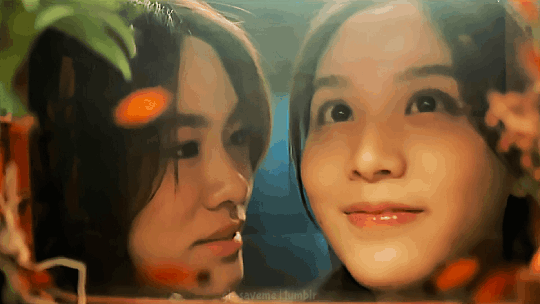
I could spend paragraphs alone on how solid the surrounding cast was. Grandma Bua's even-keeled outlook on life and death was one of the most poignant parts of the show, and Kawi was just absolutely marinated in eldest-sibling melancholy (Sing did the role so much justice). Under the sure-handed direction of p'Fon, this show tackled difficult themes in a wonderfully measured way, not shying away from trauma and dysfunction and suffering but never plunging the audience into true despair either. Loneliness was always countered by companionship, doubt soothed by affirmations, and the central romance between Pam and Dokrak underpinned all of that. I really think EmiBonnie is my favorite GL pairing to date—they delivered magnetic natural chemistry and some of the best sapphic intimacy we've seen in Thai QL, even when they weren't touching. (Also some really nice OST tracks!) I'm so excited to see what they do next.
Initial rating: 9.25
Perfect 10 Liners
This is one of those shows that I find myself having to evaluate based purely on the story and characters alone, because p'New's many, ah, idiosyncrasies as a director are a feature rather than a bug at this point, and I find it tiresome to rehash. But unlike the frictionlessness of We Are (his last project for GMMTV—I've only experienced Fourever You through fmvs and gifsets which I gather is for the best), the omnibus structure of Perfect 10 Liners had built-in vibe shifts, which worked to its favor. I must admit that the ArmArc story left absolutely no impression on me, but YothaGun and FaifaWine got progressively stronger and more compelling, thanks to the ability to develop these sets of characters across longer periods of time as well as more entangled familial relationships.

What the last two sections of the show did so well was balance its farcical + comedic elements with heavier storytelling, in the form of Yotha and Faifa's family hangups. This gave their characters more depth, reinforced by tremendous acting from Perth and Junior in those roles, which in turn enhanced the romantic dynamics and complementary healing for these two pairs in particular. The last half of FaifaWine's arc was especially satisfying, as the larger group dynamics came into play, and the final episode was honestly a riot. Completely corny and unserious, but still managed to tie a tidy bow around everyone's stories. (Except you, Pipo. GMMTV I am begging—nay, demanding—that the twins get their own comedy series in 2026. I don't care if it's QL or the most heterosexual thing ever, I think it could fix me.)
Initial rating: 7.25
And to close out, a few thoughts about some recent backlist watches (ratings in parentheses):
I finished Reverse 4 You yesterday; it was one of my list of series to catch up on (two down!), and luckily the sequel just finished airing so I can move immediately to that one. So I think I'll do a bigger write-up after finishing Reverse with Me aha sorry for the fakeout.
Fine, a real review: Be My Favorite blew me away. It is so rare to get a genre mashup BL that doesn't skimp on any of its components. BMF is a speculative coming-of-age romcom, and it delivers on all fronts thanks to a truly excellent script. I was surprised by how much I genuinely enjoyed the character work; Kawi and Pisaeng's storylines were already incredibly rendered, but the show made me care deeply about Pear, Max, Kwan, all the way down to the parental figures. It took a compassionate approach to the thesis that everyone makes mistakes in life, and everyone is bound to experience disappointment, but kindness and honesty can be a powerful salve. The optimism wasn't cloying, either, because they were lessons learned organically from each character's journey. Finally, the subverted time skip trope made me happy, the title track is one of my favorites across all GMMTV shows, and the acting was top-to-bottom stellar. (9.5)

So, I had friends telling me how good BMF was even while it was airing (thanks @merryfuture ilu), and I think part of me knew that I was keeping it on the shelf for a time when I'd truly be ready to appreciate it. And that time was after finally watching the entirety of SOTUS from start to finish and thus gaining appreciation for Krist's specific niche of BL blorbo—a project that was spurred on by some thoughtful, thorough posts from @maybe-boys-do-love and @thebroccolination (among others? sorry if I've forgotten). I have a ton of notes for these series, but to try and keep this post from spiraling totally out of control, I'll just say that SOTUS should be required viewing for anyone who wants to understand how the uni campus functions as not only a backdrop but a site of possibility in Thai BL; it also had an underrated and excellent slow burn—if a show is going to maintain a low simmer for that long, heat is still required, and between Singto's searing gaze and Krist's clenched jaw, the tension was electric. However, it's SOTUS S—and specifically Arthit's growth in this new phase of his life, that I hold dearest to me. Removing him from the campus setting, where he had seniority and power and—most importantly—a considerable level of comfort, meant he had to start from square one when it came to social interactions and finding his footing, and his relationship with Kongpob intertwined with those conflicts nicely. Character of all time, maybe. (8.0, 8.25)

Thank you for reading!
#us the series#perfect 10 liners#p10l#be my favorite#sotus#sotus the series#sotus s#well this lowkey turned into a krist appreciation post#way past my bedtime wtf i blame pipo i'm still laughing over that final scene
25 notes
·
View notes
Text
GMMTV BL series with the most sponsors in the opening credits.
Not commenting, just making an observation.
7 sponsors: SOTUS S, Still 2gether, Fish Upon the Sky, Bad Buddy




8 sponsors: Theory of Love, Cherry Magic


10 sponsors: Vice Versa

11 sponsors: My Love Mix-Up

#canon is back time for more flirting via ink cartridges#nothing will ever beat the vice versa choco pie though#sotus s#fish upon the sky#bad buddy#theory of love#cherry magic thailand#vice versa#my love mix up thailand#still 2gether
108 notes
·
View notes
Text
SOTUS WATCH PARTY CONTINUES WITH SOTUS S (2017)

Hey folks! We're wrapping up our rewatch of SOTUS with episode 15 this Saturday the 15th, and that same day we'll be beginning SOTUS S!
(SOTUS S: AKA my favorite of the three iterations. Arthit, my angel, my sweet baby boy.)

SCHEDULE (18:30 GMT)
EPISODE 1: March 15 EPISODES 2-3: March 16 EPISODES 4-5: March 23 EPISODES 6-7: March 30 EPISODES 8-9: April 6 EPISODES 10-11: April 13 EPISODES 12-13: April 20
We should be finishing up right around the time The Ex-Morning begins airing, so if you've never seen SOTUS S or you'd just like to jump in and relive KristSingto history, feel free to join us! Once The Ex-Morning begins, I'll be holding watch parties in the same server. :)
Head over to the server or directly to the watch room on Hyperbeam and I’ll see y'all this weekend!

18 notes
·
View notes
Text
you wouldn’t last an hour in the asylum where they raised me

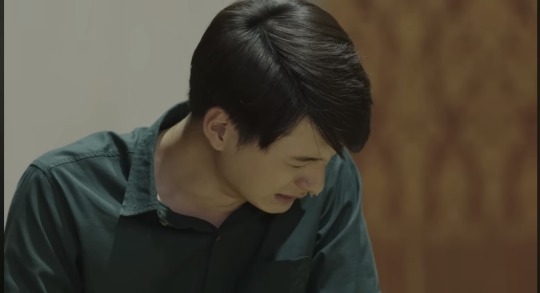
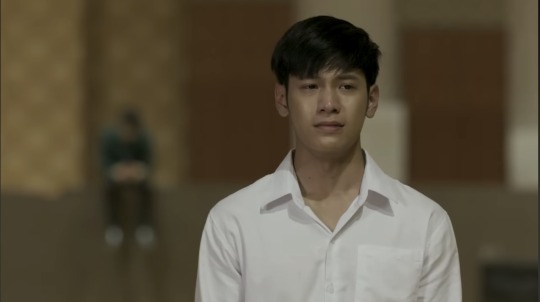
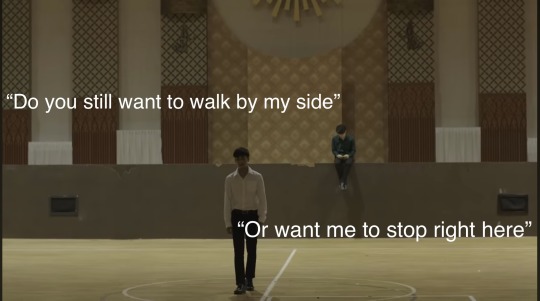
#sad gay shit#breakup#sotus s#sotus the series#krist perawat#singto prachaya#singtokrist#kristsingto#boys love boys#boys love series#queer series#kongarthit#kongart#you wouldnt last an hour in the asylum where they raised me#I watch this again and again cause your gurl MASOCHIST#whos afraid of little old me#the tortured poets department
86 notes
·
View notes
Text




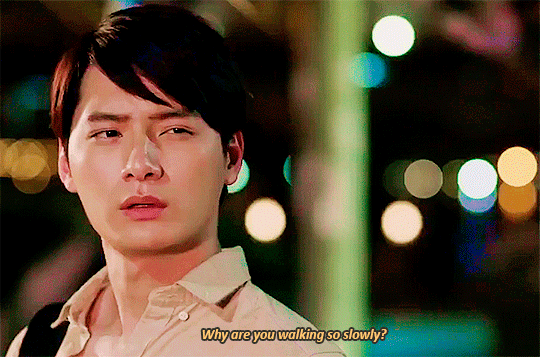
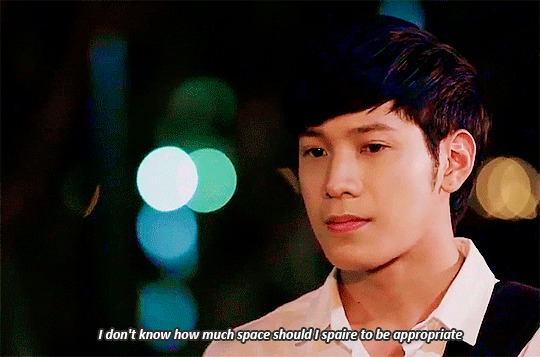
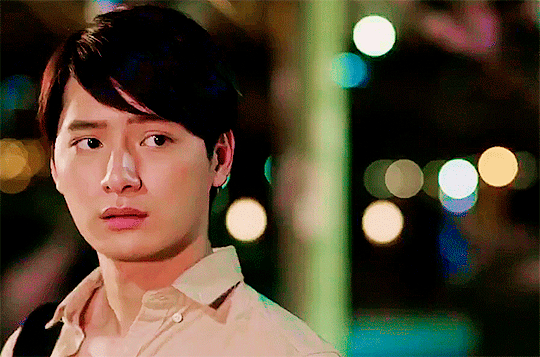

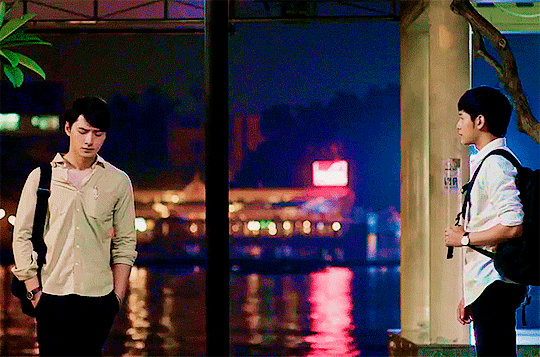




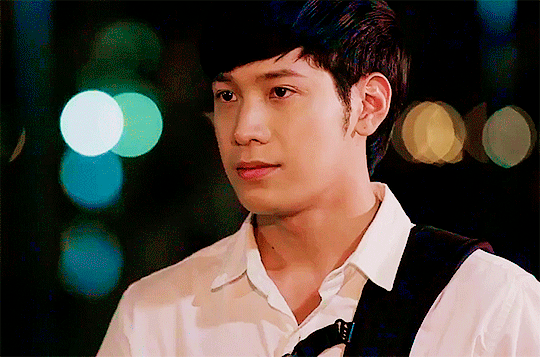
#SOTUS S#Gabriel makes stuff#Arthit Rojnapat#Krist Perawat#Kongpob Suthiluck#Singto Prachaya#Kongpob x Arthit#KongpobArthit#Thai BL#Thai series#Thai Drama#BL Drama#BL series
83 notes
·
View notes
Text
your girl just posted her first fic in the fandom
yeah its a drabble
10 notes
·
View notes
Text
Aceness in BL: Let’s go for a Ramble
(I made this post soon after Be My Favorite finished but shadowbanning has delayed the posting) - I'm Freeee (@plantsarepeopletoo @shouldiusemyname)
So, I’ve been thinking more and more about aceness in BL (mainly BL anyway), and to get my thought’s in order I thought I’d make a post.
This post is NOT intended as a blanket rule in literally any context. It is specifically about how 1. I frame aceness in my head based on very surface level research and my own experience and how 2. I apply that to a few characters (In BL) who, to me, have felt acespec.
This post will cover
A brief overview of how I understand the acespectrum (with reference to aesthetic, romantic and sexual attraction)
How I view demisexuality as a kind of doorway (with reference to my own deminess)
How I feel five characters (Ae from Love by Chance, Arthrit from SOTUS & SOTUS S, Kat from The Warp Effect (yes not BL but whatevs), Kawi from Be My Favorite and Khai from the Warp Effect) might fall on these spectrums. (THIS WILL INCLUDE SPOILERS)
A wrap up on acepectrum, transient identities, and labels
First Up the Ace-Spectrum!
(How I frame aceness in my head)
Aesthetic attraction = I really want to just stare at this person, they so pretty
Romantic attraction = I want to have this person with me, I want to hold them close and see them daily and talk to them about everything, also I want to cuddle and sleep together (maybe idk this is the attraction I am vaguest on)
Sexual attraction = I want to have sex with this person, I want to personally bang this person, I stare at this person and think about what it would be like to kiss them with tongue and push them against walls and have them underneath/on top of me. (This isn’t necessarily at like 100% all the time I think)
Kapish?
Romantic and Sexual attraction are both spectrums (obvs) and in my head they go from
Allo (100%) <------- to --------> Ace/Aro (0%) with the percentage reflective of how frequently you find people attractive, (I don’t think 100% is everybody all the time though).
So theoretically anyone not at 100% for either romantic or sexual attraction might identify as acespec, though I IMAGINE most people over perhaps, 30% feel attraction often enough that they don’t consider it, so for headcannon purposes I’m considering under 30% as ace or aro.
Sometimes people might consider themselves grey-ace (or grey-aro) if they fall within the more middling but still low percentages (say 15-50%,) So they experience attraction to individuals on occasion, but less frequently than typical. (But, again any label that people identify with is true for them)
Framing Demisexuality as a doorway
Demisexuality is, to me (in brief), not experiencing sexual attraction prior to the development of strong emotional/intellectual/romantic feelings (also can feel like a significant jump rather than completely 0-100, for me it’s almost like a switch on/off, but it can be gradual too)
Demiromantic people don’t experience romantic feelings for people unless there’s a strong emotional bond in place. (Same caveats as above)
The demi-doorway doesn’t automatically open the moment bonds/romantic feelings are developed, it’s simply that these feelings DON’T occur without the bond first. An alloromantic demisexual person MAY develop sexual feelings for someone they like romantically, but they also may not.
Personally, I consider myself demisexual and demiromantic because (based on 1.5 data points (data points = people), which is really not enough evidence) after bonds are formed both my romantic and sexual interest about a specific person jump up to allo. My deminess also feels tied to the way the changing/wavering of these emotional bonds also closes the door really quickly?? (So I can become abruptly not attracted to someone anymore if my romantic feelings/emotions are gone/destabilised, let me tell you it is weird to experience)
The lines around characters and actors and attraction gets all blurry too. Kind of like there’s a window in my door(s) that can be open or shut, but I can always look through it? (IDK how this metaphor is holding up)
For example, here’s some arbitrary categorites:
1. People are nice looking because everybody is nice looking (e.g., most people)
2. Aesthetic attraction (let me stare) e.g., Jean from The Warp Effect or Ayan from The Eclipse
3. Aesthetic attraction but more?? E.g., Joong (Joong is pretty, VERY PRETTY. But it’s still not really sexual attraction…I just want to stare at him…extra hard…and if he WANTED to fuck me…I mean for science…but I still don’t really WANT to??)
4. First. E.g., AM I EVEN ACE/ARO WHAT IS THIS SORCERY??
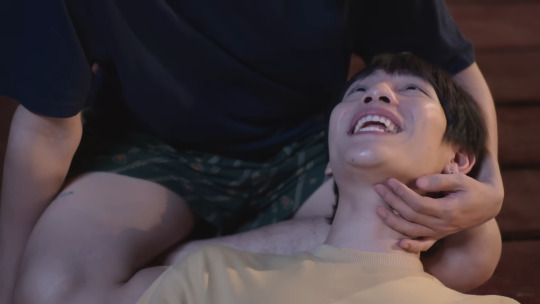
Clear as mud I’m sure.
Ace people can also dislike sex, be sex repulsed, enjoy watching, and whatever else without it emphasising or erasing their aceness, since it’s about sexual attraction to an individual more than anything else.
In a similar way you can also be sex repulsed or dislike sex or dislike aspects of sex without automatically being ace.
ALSO Demispec people may experience full (e.g. 100%) romantic/sexual feelings once the door is open without the caveats that I listed (about emotional instability) and this in NO WAY erases their aceness (or their deminess). There is also something to be said for the different ways the emotional bonds are formed/feelings are triggered. My two data points (attraction to people) were both triggered by strong intellectual connections.
ALSO acespec (which includes all aro/ace/demi people FTR) people can have gender specific (or non-specific) orientations as well (e.g. homoromantic asexual or aromantic pansexual or even biromantic bi-grey-ace).
Examples from Thailand BL/QL in my headcannon
I’m only talking about allo/ace/demi here, no gender-(non)-specific orientations.
Ae (Love By Chance) alloromantic demisexual (through the door 100%)

Ae is, I think, a pretty classic example of the most common view of demisexuality. He experiences romantic feelings for someone (idk if it’s the first time for this) and then slowly realises he’s sexually attracted to said person and goes a bit crazy because he doesn’t quite know what his feelings mean because he’s never experienced them before and, well, he’s a horndog (I love Ae and this depiction for the record) his demisexuality is absolutely a gateway to 100% sexual interest!
Some signs of his aceness might include his lack of interest in sex as commented on by his roommate and his confusion over the feelings he’s experiencing for the first time because they’re outside of his frame of experience. Also his sexual feelings seem to take a while to develop, after his crush has begun.
(I’m much less certain about romantic orientation here because we don’t know if he’s had crushes before (without wanting sex) and also he’s only 18, so even if he hasn’t doesn’t mean he’s arospec)
Arthrit (SOTUS & SOTUS S) Alloromantic demisexual (but different!!)
Arthrit seems alloromantic, in his previous feelings for his childhood friend and his clearly developing romantic feelings for Kong.
Arthit’s aceness is less clear cut than Ae’s because even after he develops sexual feelings (through the demidoor) he doesn’t experience allo sexual attraction as strongly as someone like Ae. I found a lot of his reactions to the relationship ups and downs in SOTUS S were very relatable (and prompted my first ever long post lol click for way more info on this) because of how Arthrit’s desire for sex (or sexual touch) seem to waver with the relationship stability. This is not about being uncomfortable with Kong exactly, but more about how even after they’re technically on an even keel and Kong’s sharing his bed and apartment, Arthit still seems uncomfortable with some of his sexual advances. While LATER after they’ve properly talked about it, he goes back to leaning into Kongs space and making flirty eyebrows.

So his deminess kind of means his aceness is variable even through the demidoor, like the door is wavering between open and closed. But it also doesn’t ever feel like his romantic feelings for Kong waver, just that the unstable grounding of their relationship boundaries lead to emotional instability which effect his sexual interest.
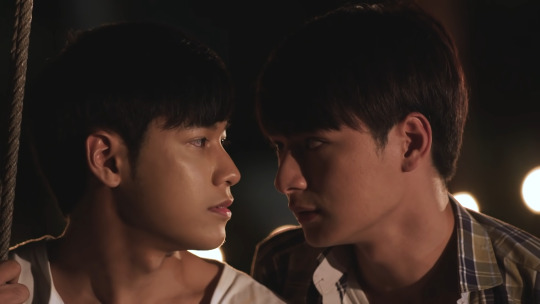
(Because I will take every excuse to use my Arthrit screenshots)
Kat in The Warp Effect (aromantic allosexual)

Honestly, Kat being Aro seemed basically canon during my viewing of The Warp Effect. She shows essentially no evidence of romantic feelings for anyone the whole series. (Though obvs people can want and have sex without wanting relationships and not be aro)
While Kat later tells Alex that she likes him (and tells Jean too) I don’t really feel like this mucks with the head-canon for a few reasons:
Kat is shown to be pretty monogamous when in sexual relationships with people even as she want’s no strings (she tells Alex he’s the only one she is currently having sex with (I think), she later tells Captain Asshole this and then later tells Tony this).
Thanks to Captain Asshole she begins to feel unsafe with the way she lives her life.
She initially wants to commit to Alex as the person she is most comfortable with, but we are not really shown any evidence of romantic feelings, just a desire for commitment.
She seems to reach a similar sort of balance with Tony in the OG Warp Timeline, but there still (to me) isn’t really evidence of romantic feelings
Aro people can, after all, want a committed and/or monogamous relationship.
Kawi in Be My Favorite (Alloromatic Asexual (not Demi IMO))

The reason I think he’s ace rather than demi is more about the language he uses even after he’s in love with Piseang (please see my thoughts about ace-kawi coding in ep 10 for more details if you're curious). Even after this wasn’t made explicit by the narrative, I stand by my thoughts around his lack of interest in sex in general. (As well as the coding in ep12 of him trying the rollercoaster and not liking it). It didn’t really feel to me like he gained sexual feelings for Piseang (unlike the vibes I personally got from Arthrit even if they wavered), more than he tried sex and enjoyed it enough to participate again in the future because he loved and felt comfortable with Piseang.
If you feel ambivalent about playing tennis, but your partner really likes playing tennis than maybe you make a point of playing tennis regularly even if it’s not something you’d think about doing on your own, because playing tennis with your partner is fun you know?
Of course, if tennis makes you feel icky, or really bored, you many not ever want to play it even if your partner enjoys it.
Khai in Theory of Love (demiromantic allosexual)

So Khai is my most recent addition to this post given I just finished ToL but he was so demiromantic it crushed me into pieces so he gets to be included! ways Khai feels demirom:
His confused realisation of feelings when he talks to his Phi at the beach.
He likes to keep things uncomplicated with the girls he’s seeing because he doesn’t do relationships.
He actually tries to take his relationships seriously but just never really seemed to genuinely want the romance.
Even after he realises he has romantic feelings for Third, when he returns back to him (after the beach reflection) he notices his sexual attraction more easily than his romantic feelings.
His confusion over how much he hurt when Third seemed to be choosing Un over him, and how it was the first time he realised how much Third must have been hurting because he’d never felt like this before.
The entirety of Ep12 with Third telling Khai what he feels isn't love (because Third has seen time and time again that Khai hasn't loved anyone before). Khai's attempts to prove himself even though he really understand what loving someone means, even as he follows his emotions, and tries hard to be “better” for Third because he does love Third, he chooses Third, he changes for Third, he cries for Third.
He also curls up in his room watching romantic movies for multiple days because Third tells him that what he's feeling isn't love and if it isn't then what is?)
Very relatable and also owie ouchie my brokenness feelings.
Lack of data points makes it tricky:
There are probably lots of other characters that COULD fall into a-spectrum, (just as there are reasons why these characters might not) but the thing I find the trickiest to navigate (for my headcanons) is lack of data points. Most characters in BL are in highschool/college, and this, combined with a desire for lack of messiness in story structure, means characters are often experiencing feelings ‘for the first time.’ Long term pining, childhood crushes, and first attraction to the same gender, all come into play and make evidence muddy and lacking a concrete foundation, from which to draw conclusions.
We can’t ask characters about their preferences, previous feelings, levels of emotion etc. so in my opinion conclusions can’t be drawn, only inferences made.
I don’t have a problem with anyone headcannoning these characters as not acespec.
I don’t have a problem with anyone headcannoning other characters as acespec.
Identities, Transience and Labelling
In discussing this post and my own framework with a couple of people I wanted to add a bit more of my personal experience with the ace label and the ace spectrum. Because the thing about both ace-ness and allo-ness is that they’re not equal all the time. Some people experience sexual attraction first or more frequently and may only experience romantic feelings later or less frequently. Some people feel romantic attraction before sexual, but only sometimes and sometimes people feel both at once and straight away, or both at once but only later on…
The romantic and sexual attraction spectrums are spectrums that everybody exists on and in existing on a spectrum some people have a firm placement and others a shifting one.
People who are ace-identified are typically those who have felt meaningfully different from their peers in the level and/or frequency of experiencing any sexual attraction and/or any romantic attraction and whose attraction is close to zero for one or both of those spectrums. They have thus sought out explanations for their difference and found the ace labels. Demi-ness, on either spectrum, then relates more to the way emotional(/intellectual) bonds, positive or negative, directly impact your ability to feel romantic or sexual attraction.
In the context of TV, for me, it’s picking up a photo of a character you love and being confused when they don’t seem right anymore. Its looking at a cast of beautiful humans and not really feeling anything but awe at their acting. It’s forgetting that characters were shirtless until the gifs show up on your dash the next day. It’s reading the definition of chemistry and not really understanding what it means. It’s not realising that there’s a difference between kisses where the lips move and kisses where they don’t because the way the characters talk and stand and stare means so much more. It’s so many things until you must notice because what you’re seeing and noticing and caring about is just…not the same as the things other people are seeing, noticing and caring about.
In the real world it’s messier, because aceness is sometimes framed as only 0%. Experiencing emotions outside of 0% can make the label feel hard to keep, or wrong or mismatched:
My 16-year-old-self called herself Asexual and was relieved to have found a reason why she felt so weird, even if it didn't quite fit right.
My 18-year-old-self called herself maybe-bi because both boys and girls can be pretty to look at, and this must be what crushes are right?
My 20-year-old-self called herself Asexual again (even though it still didn't fit right) because she’d tried things with one of these apparent crushes and it just felt…weird.
My 22-year-old-self called herself maybe straight afterall because she dreamed about kissing someone for the first time and that person was a boy.
My 24-year-old-self picked up demisexual and clung to it like a lifeline because why else would her attraction just be…gone. Was I broken?
My 25-year-old-self discovered demiromantic was also a label and felt like things finally made sense.
But what’s important to know is that at no point between finding the asexual label at 16 to finding the aromantic label at 25, was I not aro/ace. And that if I had settled on a non-aspec label after any one of my identity-questioning experiences, it wouldn’t have made me a liar at any age or negated the experience of other aspec people in any way.
Because what my 25-year-old-self now understands is that labels aren’t there to put you in a box and squeeze you into shape, nor are labels there to lay across your shoulders and weigh you down with their expectations.
The labels are a lifeline, a hand reaching out, a voice whispering in the darkness…
You are not, and have never been alone.
So, for me at least, to label characters as this or that, is not to box them in, instead it is pointing and gasping, look, look, that one is like me…or maybe, look, look, that one is like you.
When a character acts the way I would, thinks the way I would, talks the way I would I am again reminded that,
I are not, and have never been alone.
So please, label away, I don’t mind if we pick different labels. I just like that I can share my labels with you.
#Rturts is wondering#acespec in bl#for the queer#be my favorite#theory of love#the warp effect#love by chance#SOTUS#SOTUS S#asexuality#aromantic#ace spectrum#aspectrum#demisexuality#demiromantic#demisexual#aromantism#roc talks aro/ace
102 notes
·
View notes
Text
In case anyone was wondering, I’ve been working on my SOTUS S write-up for around 7-8 hours every weekend for over a month. It’s not abandoned, just being used as a vehicle for a bigger topic for which I needed to research a lot more. Hopefully will be done with it by the end of Feb!
21 notes
·
View notes
Text
There are 5 cable-stayed bridges that cross the Chao Phraya River: Rama VIII, Rama IX, Bhumibol 1 and 2, Kanchanaphisek Bridge.
Of the 5, only Rama VIII and Bhumibol 1 and 2 bridges have been featured in shows and are frequently confused.
*Bhumibol 1 and 2 are connected to each other and will be referred to in conjunction with the other.
Full credit to @virtualtadpole who told me that the way to identify the bridges is by looking at the shape of their pylons:
Rama VIII's is an upside down Y, Rama IX has straight columns, Bhumibol's are diamond shaped, and Kanchanaphisek's are As
Rama VIII Bridge KinnPorsche, My Ride, Cutie Pie, Boyband, Even Sun, Tonhon Chonlatee, Enchante, SOTUS, SOTUS S, Our Skyy x SOTUS (only 1 photo from Our Skyy x SOTUS), Absolute Zero and its trailer, I Promised You the Moon, Gen Y, 2 Moons 3: The Ambassador, Moments of Love



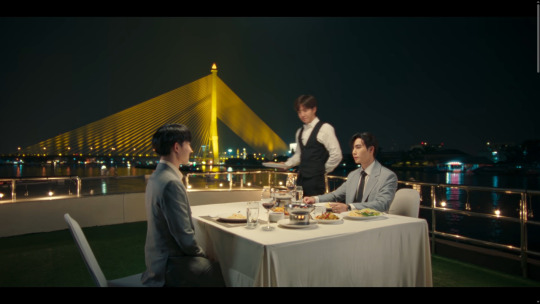







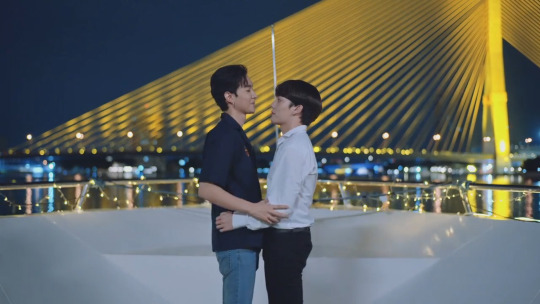
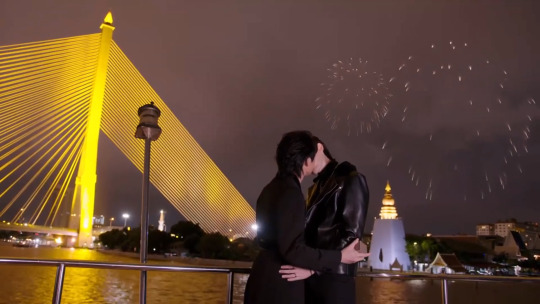

Rama IX Bridge

Bhumibol 1 and 2 Bridges KinnPorsche, A Boss and a Babe, Big Dragon, Not Me, Pit Babe, Cooking Crush, Love in the Air


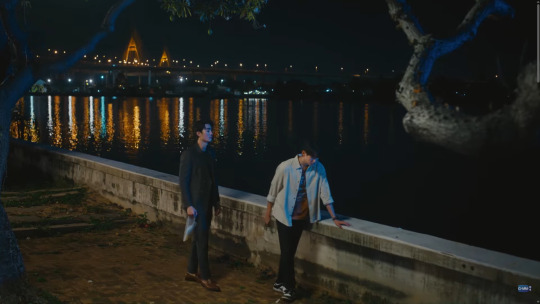

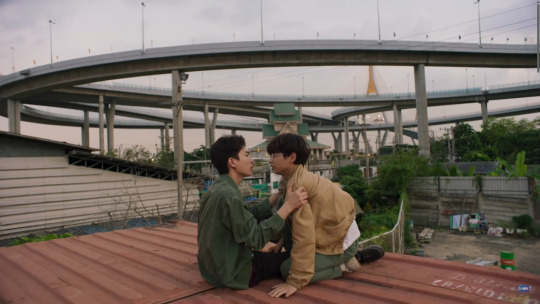



Kanchanaphisek Bridge

References:
@absolutebl's BL Visual Trope Du Jour: Boys on bridges post
@virtualtadpole's The Rama VIII Bridge in Bangkok post
The less glamorous siblings of the cable stayed bridges
#shared + spotted in thai (mostly) ql#bridges across the chao phraya river#kinnporsche#my ride the series#cutie pie the series#boyband the series#even sun the series#tonhon chonlatee#enchante the series#sotus#sotus s#our skyy x sotus#absolute zero#i promised you the moon#gen y the series#2 moons 3#2 moons 3: the ambassador#moments of love#a boss and a babe the series#big dragon the series#not me the series#pit babe the series#cooking crush the series#love in the air the series
40 notes
·
View notes